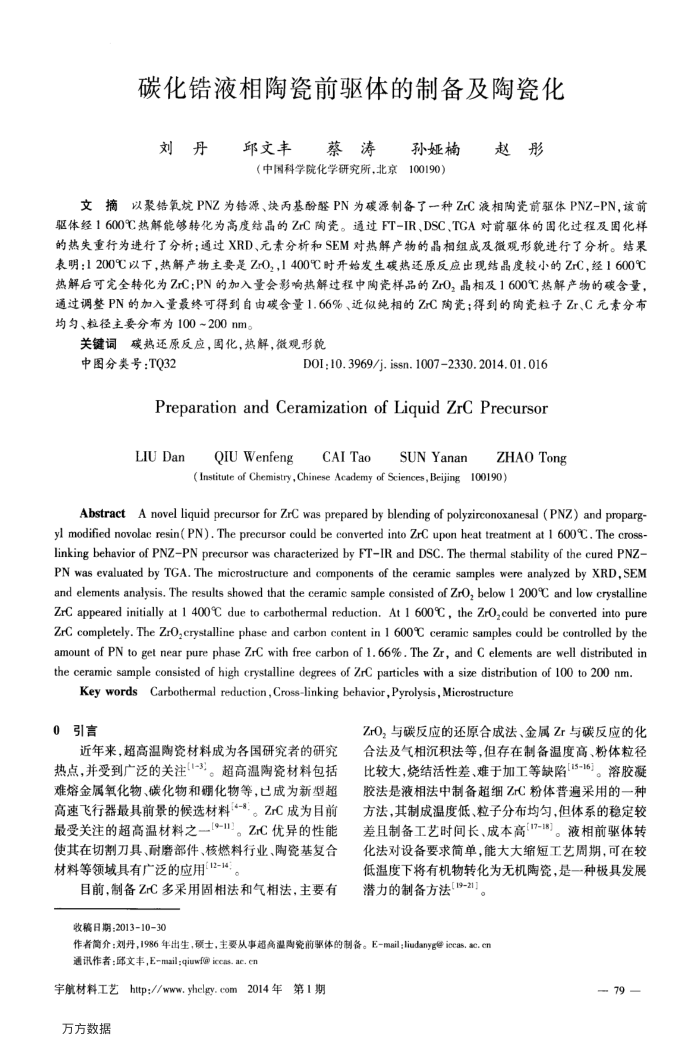您当前的位置:首页>论文资料>碳化锆液相陶瓷前驱体的制备及陶瓷化
内容简介
 碳化锆液相陶瓷前驱体的制备及陶瓷化
碳化锆液相陶瓷前驱体的制备及陶瓷化刘丹邱文丰蔡涛孙娅楠
(中国科学院化学研究所,北京100190)
赵
文摘以聚结氧烷PNZ为铸源、炔丙基酚醛PN为破源制备了=种ZrC液相陶瓷前驱体PNZ-PN,该前驱体经1600℃热解能够转化为高度结晶的ZrC陶瓷。通过FT-IR、DSC、TGA对前驱体的围化过程及围化样的热失重行为进行了分析;通过XRD、元素分析和SEM对热解产物的晶相组成及微观形貌进行了分析。结果表明:1200℃以下,热解产物主要是Zr0,,1400℃时开始发生碳热还原反应出现结晶度较小的ZrC,经1600℃ 热解后可完全转化为ZrC;PN的加入量会影响热解过程中陶瓷样品的ZrO,晶相及1600℃热解产物的碳含量,通过调整PN的加入量最终可得到自由碳含量1.66%、近似纯相的ZrC陶瓷;得到的陶瓷粒子Zr、C元素分布均匀、粒径主要分布为100~200nm。
关键词碳热还原反应,固化,热解,微观形貌
中图分类号:TQ32
D0I:10.3969/j. issn.10072330.2014.01.016
PreparationandCeramizationofLiquidZrCPrecursor
LIUDan
QIUWenfeng
CAI Tao
SUNYanan
ZHAO Tong
( Institute of Chemistry, Chinese Academy of Sciences,Beijing100190)
AbstractA novel liquid precursor for ZrC was prepared by blending of polyzireonoxanesal (PNZ) and proparg-yl modified novolac resin( PN). The precursor could be converted into ZrC upon heat treatment at 1 600C. The cross linking behavior of PNZPN precursor was characterized by FTIR and DSC. The thermal stability of the cured PNZ-PN was evaluated by TGA. The microstructure and components of the ceramic samples were analyzed by XRD, SEM and elements analysis. The results showed that the ceramic sample consisted of ZrO, below 1 200C and low crystalline ZrC appeared initially at 1 400°C due to carbothermal reduction. At 1 600°C, the ZrO, could be converted into pure ZrC completely. The ZrO, crystalline phase and carbon content in 1 600°C ceramic samples could be controlled by the amount of PN to get near pure phase ZrC with free carbon of 1. 66%. The Zr, and C elements are well distributed in the ceramic sample consisted of high crystalline degrees of ZrC particles with a size distribution of 100 to 200 nm.
Key wordsCarbothermal reduction, Cross-linking behavior,Pyrolysis,Microstructure
0引言
近年来,超高温陶瓷材料成为各国研究者的研究热点,并受到广泛的关注1-3。超高温陶瓷材料包括难熔金属氧化物、碳化物和硼化物等,已成为新型超高速飞行器最具前景的候选材料4-8:。ZrC成为目前最受关注的超高温材料之—[9-1]。ZrC优异的性能使其在切割刀具、耐磨部件、核燃料行业、陶瓷基复合材料等领域具有广泛的应用[12-14
目前,制备ZrC多采用固相法和气相法,主要有收稿日期:2013-1030
ZrO,与碳反应的还原合成法、金属Zr与碳反应的化合法及气相沉积法等,但存在制备温度高、粉体粒径比较大,烧结活性差、难于加工等缺陷【"5-16]。溶胶凝胶法是液相法中制备超细ZrC粉体普遍采用的一种方法,其制成温度低、粒子分布均匀,但体系的稳定较差且制备工艺时间长、成本高[17-18)。液相前驱体转化法对设备要求简单,能大大缩短工艺周期,可在较低温度下将有机物转化为无机陶瓷,是一种极具发展潜力的制备方法[19-21
作者简介:刘丹,1986年出生,硕士,主要从事超高温购瓷前驱聚体的制备。E-mail:liudanygeiccas.ac.c 通讯作者:邱文丰,E-mail:qiuwf@ iccas.ac.cn
宇航材料工艺http://www.yhelgy.com2014年第1期万方数据
79